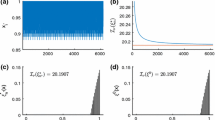Abstract
The discrepancy is an important optimality criterion for experimental designs. Sometimes for practical reasons one may choose a design on some finite subset of the original experimental domain. This article addresses the question of whether minimum discrepancy designs are the same for the discrepancy defined on the original experimental domain and the discrepancy defined on a subset. Under certain non-trivial conditions they are shown to be equivalent. Examples are given to show when these conditions apply.
Similar content being viewed by others
References
Bates RA, Buck RJ, Riccomagno E, Wynn HP (1996) Experimental design and observation for large systems. J R Stat Soc B 58:77–94
D’Agostino RB, Stephens MA ed. (1986) Goodness-of-fit techniques. Marcel Dekker, New York
Dudley RM (2002) Real analysis and probability. Cambridge studies in advanced mathematics, No 74. Cambridge University Press, Cambridge
Fang KT, Lin DKJ, Liu MQ (2003) Optimal mixed-level supersaturated design. Metrika 58(3):279–291
Fang KT, Lin DKJ, Winker P, Zhang Y (2000) Uniform design: theory and applications. Technometrics 42:237–248
Fang KT, Mukerjee R (2000) A connection between uniformity and aberration in regular fractions of two-level factorials. Biometrika 87:193–198
Fang KT, Wang Y (1994) Number-theoretic methods in statistics. Chapman and Hall, London
Hickernell FJ (1999) Goodness-of-fit statistics, discrepancies and robust designs. Stat Probab Lett 44:73–78
Hickernell FJ (2000). What affects the accuracy of quasi-Monte Carlo quadrature. In: Niederreiter H, Spanier J (eds). Monte Carlo and Quasi-Monte Carlo methods (1998). Springer, Heidelberg New York, Berlin, pp 16–55
Hickernell FJ, Liu MQ (2002) Uniform designs limit aliasing. Biometrika 89:893–904
Hickernell FJ, Yue RX (2000) The mean square discrepancy of scrambled (t,s)-sequences. SIAM J Numer Anal 38:1089-1112
Liu MQ, Hickernell FJ (2002) E(s 2)-optimality and minimum discrepancy in 2-level supersaturated designs. Stat Sinica 12(3):931–939
Niederreiter H (1992) Random number generation and quasi-Monte Carlo methods. In: CBMS-NSF regional conference series in applied mathematics, SIAM, Philadelphia
Saitoh S (1988) Theory of reproducing kernels and its applications. Longman Scientific & Technical, Essex, England
Wahba G (1990) Spline models for observational data. In: CBMS-NSF regional conference series in applied mathematics, SIAM, Philadelphia
Wang Y, Fang KT (1981) A note on uniform distribution and experimental design. KeXue TongBao 26:485–489
Weyl H (1916) Über die Gleichverteilung der Zahlen mod eins. Math Ann 77:313–352
Author information
Authors and Affiliations
Corresponding author
Rights and permissions
About this article
Cite this article
Liu, MQ., Hickernell, F.J. The Relationship Between Discrepancies Defined on a Domain and on its Subset. Metrika 63, 317–327 (2006). https://doi.org/10.1007/s00184-005-0022-y
Received:
Accepted:
Published:
Issue Date:
DOI: https://doi.org/10.1007/s00184-005-0022-y




